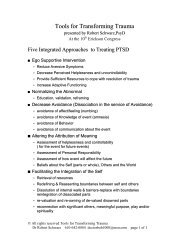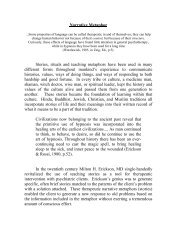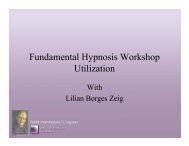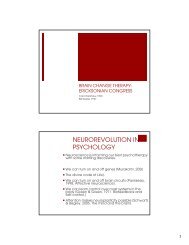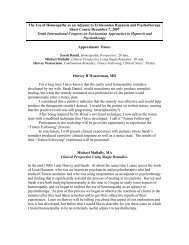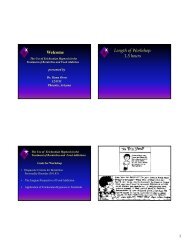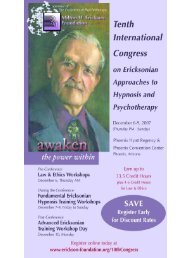Workshop 15 Handouts - The Eleventh International Erickson ...
Workshop 15 Handouts - The Eleventh International Erickson ...
Workshop 15 Handouts - The Eleventh International Erickson ...
Create successful ePaper yourself
Turn your PDF publications into a flip-book with our unique Google optimized e-Paper software.
<strong>Workshop</strong> WS <strong>15</strong><br />
Expectation: <strong>The</strong> Essence of<br />
Very Brief <strong>The</strong>rapy<br />
11th <strong>International</strong> Congress on<br />
<strong>Erickson</strong>ian Approaches to<br />
Hypnosis and Psychotherapy<br />
December 9, 2011 1:00 – 3:00 pm<br />
Transforming <strong>Erickson</strong>ian Methods<br />
Presenter: Rubin Battino, MS, Mental Health<br />
Counseling<br />
Adjunct Professor Department of Human<br />
Resources (counseling), Wright State University<br />
440 Fairfield Pike, Yellow Springs, OH 45387<br />
rubin.battino@wright.edu.<br />
www.rubinbattino.com<br />
9/6/2011<br />
1
Outline of Talk<br />
• Introduction – brief history of brief therapy<br />
• Central role of expectation<br />
• <strong>The</strong>ory of Change<br />
• As-If and the Miracle Question<br />
• Ambiguous Function Assignments<br />
• Ordeal <strong>The</strong>rapy<br />
• Inclusivity <strong>The</strong>rapy<br />
• Metaphor Basics<br />
Outline continued<br />
• Narrative <strong>The</strong>rapy<br />
• RB’s Guided Metaphor<br />
• Rossi’s Four-Step Approaches<br />
• NLP Approaches<br />
• When All Else Fails<br />
• Universal Very Brief <strong>The</strong>rapy Intervention<br />
Experiential Exercises Throughout<br />
(instead of lecturing)<br />
9/6/2011<br />
2
Educational Objectives<br />
• To understand the central importance of<br />
expectation in doing very brief therapy<br />
• To describe two or three methods that can be<br />
used for very brief therapy that use hypnosis<br />
Brief History of Brief <strong>The</strong>rapy<br />
• Psychoanalysis. Brief = 50 sessions<br />
• De Shazer et al. study: 5 vs.10 sessions<br />
• Moshe Talmon’s Single Session <strong>The</strong>rapy<br />
a. 85% satisfaction rate<br />
b. NO correlation between clients and therapists on<br />
what they said helped<br />
c. NO correlation with therapist orientation<br />
RB’s definition of very brief therapy = 1 or 2 sessions<br />
9/6/2011<br />
3
Central Role of EXPECTATION<br />
• My expectation has a great deal to do with it [success rate].<br />
... I have worked with people who have failed to learn with<br />
other people. <strong>The</strong>y say, “<strong>The</strong> difference is I know you<br />
believe.” Kay Thompson<br />
• I’m inclined to entertain the notion that the relative efficacy<br />
of most psychotherapeutic methods depends almost<br />
exclusively on how successful the therapist is able to make<br />
the methods fit the clients’ expectation. Jerome Frank<br />
• <strong>The</strong> effectiveness of placebos results from their ability to<br />
mobilize clients’ expectancies for improvement.<br />
Frank and Frank<br />
Does Expectation = Placebo = Expectation?<br />
Freud (1960) reported<br />
that he cured Gustav<br />
Mahler’s sexual<br />
impotence during a<br />
single long walk<br />
in a park in Vienna!<br />
9/6/2011<br />
4
“What are you willing to change today?”<br />
Mary Goulding’s opening remark<br />
“When are you able to control the problem<br />
rather than it controlling you?”<br />
David Nylund’s narrative therapy question<br />
“Please do not tell me anything you do not wish to<br />
tell me.”<br />
Milton <strong>Erickson</strong>’s frequent opening remark.<br />
9/6/2011<br />
5
When patients come into my office,<br />
I greet them with a blank mind and I<br />
look them over to see who and what<br />
and why they are without taking<br />
anything for granted.<br />
<strong>Erickson</strong><br />
“Whenever I have an hypothesis about<br />
what is going on in my client, I lie down<br />
until it goes away.”<br />
Bill O’Hanlon (citing someone else)<br />
9/6/2011<br />
6
RB’s Model of <strong>The</strong>rapy<br />
Client is stuck because a stimulus in<br />
environment yields ONE interpretation<br />
which yields ONE response.<br />
<strong>The</strong>rapist’s job is to help client find other<br />
interpretations and other responses. That<br />
is, help the client to realize CHOICE.<br />
Or go from involuntary to voluntary behavior.<br />
<strong>The</strong>ory of Change<br />
Watzlawick, Weakland & Fisch (1974)<br />
• First-Order Change: characterized by<br />
dong more of the same. That is, working<br />
within the system.<br />
• Second-Order Change: external to or meta<br />
to or outside the system. Paradoxical,<br />
illogical, unexpected, puzzling, strange.<br />
• Reframing (content or context) is the<br />
approach of choice.<br />
9/6/2011<br />
7
AS-IF<br />
• Acting “As-If” is magical<br />
• No physiological differences between real and<br />
acted emotions<br />
• On coin-toss have spouse act next day as-if<br />
relationship is improving.<br />
• Act as-if chemotherapy were a gift from God<br />
(rather than a poison).<br />
• Act as-if you were happy, etc.<br />
Miracle Question from Solution-focused<br />
Brief <strong>The</strong>rapy<br />
“Suppose that tonight while you are asleep<br />
that a miracle occurs, and the miracle is that<br />
what prompted you to come talk with me<br />
today is realistically solved and resolved.<br />
When you wake up tomorrow morning, what<br />
will have changed in your life? What will be<br />
different? How will you and others know<br />
that the miracle has occurred?”<br />
9/6/2011<br />
8
Ambiguous Function Assignments<br />
• Assign an ambiguous, but specific task.<br />
• <strong>The</strong>rapist expects that the client will discover<br />
useful solutions, insights, and information.<br />
Assignments must be safe.<br />
• Some Assignments: climb something; walk in<br />
the woods or mall being alert; carry some<br />
(heavy) symbolic object; random reading; visit a<br />
museum, zoo, botanical garden, circus with<br />
expectation.<br />
Ordeal <strong>The</strong>rapy<br />
• Characteristics: must be more severe than the<br />
problem; generally related to the symptom;<br />
usually involves something beneficial like<br />
exercise; must be do-able by client; does not<br />
harm; link to occurrence of symptom.<br />
• Some Ordeals: exercise in the middle of the<br />
night; catch up on reading or filing or writing;<br />
house-cleaning and other chores.<br />
9/6/2011<br />
9
Inclusivity <strong>The</strong>rapy – Bill O’Hanlon<br />
Clients and therapists tend to think EITHER/OR rather<br />
than BOTH/AND. Either a person is depressed or not.<br />
Clients can be released from this restricting bifurcation<br />
by oxymoronic suggestions:<br />
• happily sad or sadly happy<br />
• depressingly energetic or energetically depressed<br />
• calmly tense or tensely calm<br />
• you can feel angry, and you don’t have to feel angry<br />
• you can forgive and not forgive at the same time<br />
• that was either a terrible thing or it wasn’t<br />
Metaphor – <strong>The</strong>rapist or Client-Generated<br />
• Metaphors need to be sufficiently VAGUE and involve<br />
MANY possibilities. Client picks what he/she needs<br />
from the choices.<br />
• Some Basic <strong>The</strong>mes: visit to guru or wise person;<br />
hero’s journey; construction of a building; weaving;<br />
baking; sailing; growing plants<br />
• Richard Kopp: client-generated metaphors<br />
9/6/2011<br />
10
Narrative <strong>The</strong>rapy – Michael White<br />
and David Epston<br />
• <strong>The</strong> person is not the problem – the problem is<br />
the problem<br />
• Externalization: the client’s behavior is<br />
controlled by an internal negative thing or spirit<br />
or gremlin. Exorcise this demon.<br />
• Uses family history, life history, social network,<br />
letters, certificates of achievement, etc.<br />
Guided Metaphor: Everyone has and is<br />
a story they tell themselves and others.<br />
Six Steps of Guided Metaphor<br />
• Introduction about life stories<br />
• Elicitation of “old” life story with sentence plus word or<br />
phrase.<br />
• Elicitation of “new” life story with sentence plus word<br />
or phrase.<br />
• Elicit how new life story has changed their future.<br />
• Delivery of personal life metaphors and future.<br />
• Ratification and re-orientation.<br />
9/6/2011<br />
11
Rossi’s Basic Four-Step Approach<br />
• Establish that client is ready to work.<br />
• Do inner search of all material relevant to<br />
concern.<br />
• Review all possible realistic options to solve or<br />
resolve that concern.<br />
• Ratify with an ideomotor signal (a kinesthetic<br />
anchor) that client will choose option(s).<br />
Rossi’s “Moving Hands”<br />
• Hands out in front move towards each other –<br />
readiness<br />
• One hand and arm drift down – inner search<br />
• Other hand and arm drift down – search for<br />
realistic solutions<br />
• Nod head to indicate willingness to use<br />
solution(s) - ratification<br />
9/6/2011<br />
12
NLP Approaches<br />
• “Swish” method using submodalities<br />
• Time-Line <strong>The</strong>rapy<br />
• V-K Dissociation for phobias<br />
• Six-Step Reframing<br />
• Changing Personal History<br />
• Meta-Model of language usage<br />
• Really Listen<br />
• Ask the Client<br />
• Minimalism (Rossi)<br />
• Switch Roles<br />
When All Else Fails<br />
• Look at yourself from …<br />
• Provocative <strong>The</strong>rapy (Farrelly)<br />
• Crystal Ball and Pseudo-Orientation in Time<br />
• Universal Very Brief <strong>The</strong>rapy Intervention<br />
9/6/2011<br />
13
It is the expectation of the therapist<br />
that therapy can be both very brief<br />
and effective that is the essence of<br />
working in the very brief mode.<br />
THANK YOU<br />
9/6/2011<br />
14



